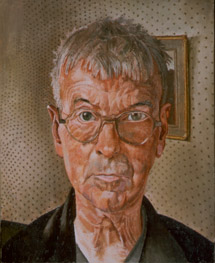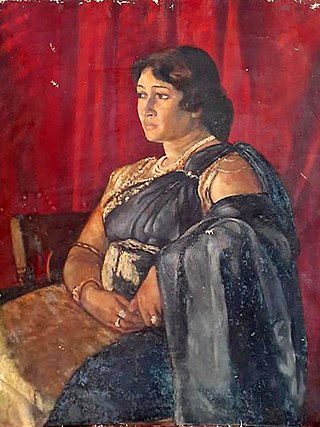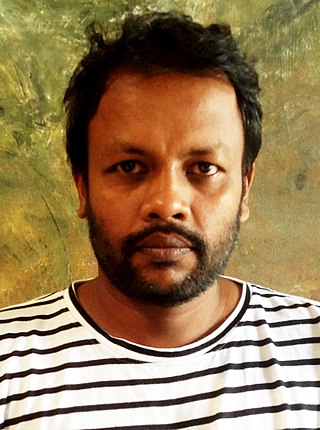Related Research Articles

Frank Helmut Auerbach is a German-British painter. Born in Germany, he has been a naturalised British subject since 1947. He is considered one of the leading names in the School of London, with fellow artists Francis Bacon and Lucian Freud.

Sir Stanley Spencer, CBE RA was an English painter. Shortly after leaving the Slade School of Art, Spencer became well known for his paintings depicting Biblical scenes occurring as if in Cookham, the small village beside the River Thames where he was born and spent much of his life. Spencer referred to Cookham as "a village in Heaven" and in his biblical scenes, fellow-villagers are shown as their Gospel counterparts. Spencer was skilled at organising multi-figure compositions such as in his large paintings for the Sandham Memorial Chapel and the Shipbuilding on the Clyde series, the former being a First World War memorial while the latter was a commission for the War Artists' Advisory Committee during the Second World War.
George Percival Sproule Keyt, was a Sri Lankan painter. He is often considered Sri Lanka's most distinguished modern painter. Keyt's dominant style is influenced by cubism. He also claimed to be influenced by his contemporary Henri Matisse and the ancient Buddhist art and sculpture of Nagarjunakonda, Sanchi and Gandhara. The Jataka tales formed a recurring theme in many of his works.
Tissa Ranasinghe was a Sri Lankan artist known for his work in bronze. Born in 1925 the village of Yogiyana, he studied art at the College of Fine Arts, Colombo, in 1949, the year it was opened in the enthusiastic flowering of Ceylonese culture that followed the country's independence. After earning a diploma in 1952 he continued his studies at Britain's Chelsea School of Art and then the Royal College of Art, receiving a certificate in bronze casting.

Sayed Haider Raza was an Indian painter who lived and worked in France for most of his career. Born on 22 February 1922 in Kakkaiya, Central Provinces, British India, Raza moved to France in 1950, marrying the French artist Janine Mongillat in 1959. Following her death from cancer in 2002, Raza returned to India in 2010, where he would live until his death on 28 July 2016.
Ivon Hitchens was an English painter who started exhibiting during the 1920s. He became part of the 'London Group' of artists and exhibited with them during the 1930s. His house was bombed in 1940 during World War II. Hitchens and his family abandoned London for the Sussex countryside, where he acquired a small area of woodland on Lavington Common, and lived there in a caravan, which he gradually augmented with a series of buildings. It was here that the artist further developed his fascination with the woodland subject matter, and this pre-occupation continued until the artist's death in 1979.
Carel Victor Morlais Weight, was an English painter.

D. Raja Segar known as Segar, is a Sri Lankan artist and sculptor. He primarily does figure painting, with an interest in religious figures, such as Buddha and Ganesha, and everyday South Asian life. He describes his style as "refractive".
British official war artists were a select group of artists who were employed on contract, or commissioned to produce specific works during the First World War, the Second World War and select military actions in the post-war period. Official war artists have been appointed by governments for information or propaganda purposes and to record events on the battlefield; but there are many other types of war artist.
Ivan Peries was a founder member of the Colombo '43 Group of Sri Lankan artists, and became one of its leading painters. Born near Colombo, he spent more than half his life in self-imposed exile in London and Southend-On-Sea, but his art remained to the end a prolonged meditation on his native Sri Lankan experience.
The War Artists' Advisory Committee (WAAC), was a British government agency established within the Ministry of Information at the outbreak of the Second World War in 1939 and headed by Sir Kenneth Clark. Its aim was to compile a comprehensive artistic record of Britain throughout the war. This was achieved both by appointing official war artists, on full-time or temporary contracts and by acquiring artworks from other artists. When the committee was dissolved in December 1945 its collection consisted of 5,570 works of art produced by over four hundred artists. This collection was then distributed to museums and institutions in Britain and around the world, with over half of the collection, some 3,000 works, going to the Imperial War Museum.
Rupert Norman Shephard was an English painter, illustrator and art teacher.
The '43 Group was a 20th-century modern art school established in August 1943 in Colombo, Sri Lanka.

Nawi Samaraweera is a Sri Lankan artist, born 26 July 1947 in Kamburupitiya, Matara.
Kathleen Guthrie was a British artist who exhibited with the London Group and at the Royal Academy and also had several solo exhibitions. During a long career Guthrie painted in oils and watercolours, produced silkscreens and murals and wrote and illustrated children's books.
William James Geoffrey Beling was a Sri Lankan artist, educator and one of the founding members of the Colombo '43 Group.
Anoma Wijewardene is a Sri Lankan contemporary artist. Wijewardene's paintings and installations reflect themes of sustainability, diversity and peace. She has held exhibitions around the world, including Venice, London, Sydney, Dubai, New Delhi, Hong Kong, Maldives and Colombo.
Pamela Drew was a British artist known for her paintings of marine and aviation subjects. Although Drew was born in the north of England she spent considerable periods of her career in Ireland.

Charles Henry D. Freegrove Winzer (1886–1940) was a British painter and lithographer. He lived in Paris, and was interned by Germany in World War I. Afterwards, he worked in Sri Lanka, until retirement to Vienna. He is widely regarded as a leading light in the introduction of modern art to Sri Lanka.

Chamila Gamage is a Sri Lankan Contemporary Artist and Sculptor. His innate talent can be seen through number of different mediums including painting and drawing, sculpting and set designing. Chamila's styles are abstract art, modern art, expressionism art.
References
- 1 2 3 4 David Buckman (1998). Artists in Britain Since 1945 Vol 1, A to L. Art Dictionaries Ltd. ISBN 0-95326-095-X.
- 1 2 3 Neville Weeraratne (23 June 1999). "George Claessen". The Guardian. Retrieved 11 September 2017.
- ↑ "Scheme for War Pictures by Native-born Colonial artists". Imperial War Museum. Retrieved 11 September 2017.
- ↑ "ARP Practice: Dealing with Casualties". Imperial War Museum. Retrieved 11 September 2017.
- ↑ Grant M. Waters (1975). Dictionary of British Artists Working 1900-1950. Eastbourne Fine Art.